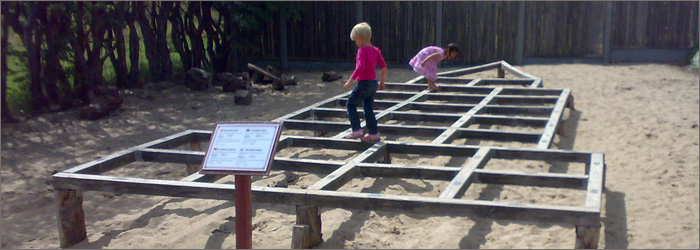
Der er flere franske katedraler, hvor en labyrint indgår i forskellige sammenhænge. Labyrinten på kirkegulvet i Chartres er nok den mest kendte, og samtidig den største endnu eksisterende kirkelabyrint.
Chartres-labyrinten er, ligesom Trojaborg-labyrinten, en såkaldt énvejs-labyrint. Dvs. at når man er nået ind til målet i midten, så har man været igennem alle gangene. Der er ingen blindgange. Man bliver ligesom ført hele vejen ind og ud. Der er ét kontinuerligt og harmonisk gangforløb.
Chartres-labyrinten er et gammelt klassisk mønster, som stammer fra Middelalderen. I byen Chartres i Frankrig (lidt syd-vest for Paris) kan man stadig den dag i dag se dette mønster som en gulvmosaik i den gamle katedral.
Det får man et ret klart billede af, når man sammenstykker beretninger fra forskellige franske katedraler, der enten har eller har haft labyrinter.
I disse katedraler dansede biskoppen i tilslutning til Påskeandagten sammen med dekanen og andre gejstlige (i andre beretninger er det i spidsen for pilgrimme) en slags påskedans som udtryk for glæden over livets sejr over døden. Ved dansens begyndelse overgav yngste kannik en stor bold til dekanen eller biskoppen. Bolden var så stor, at han ikke kunne holde den i én hånd. Derefter dansede man højtideligt i en bestemt tre-delt rytme (Tripudium) gennem labyrintens gange, og samtidig kastede biskoppen bolden op i luften, stadig højere og højere. Tydeligvis et billede på den højere stigende sol ved forårstide. De andre gejstlige fulgte ham i en lang kæde, alle syngende den gamle påskehymne ”Victimae Paschali Laudes” ledsaget af orglet.
Senere berettes det, at bodfærdige krøb på knæene gennem labyrinten, mens de bad bønner. En sådan bodsgang kunne nogle gange vare en hel time.
Fotos af kirkelabyrinterne i Frankrig er taget af Jeff Saward, Labyrinthos, www.labyrinthos.net.



Gl. Ryvej 2, Rodelund
DK-8653 Them
Gl. Ryvej 2, Rodelund
DK-8653 Them

I Labyrinthia kan du vælge, om du vil købe mad i caféen, og spise den indenfor eller ude på den sydvendte terrasse.
Du kan også selv medbringe mad, og spise den udenfor.
Vi har også to store gas-grill, så du kan grille noget medbragt mad, hvis du har lyst til det.
NB: Der er gratis ”vovsebar” (frisk vand) til vores tørstige firbenede gæster.
I Caféen har vi et lækkert udbud af mad og drikke. Nyd blandt andet frisksmurte sandwich, pølser, Fish n’ chips, baristakaffe, sluch-ice, is og meget mere.

Skab den perfekte base til jeres børnefødselsdag, firmafest, skoleudflugt eller andet arrangement ved at leje vores picnic-telt!
Her kan I samles, hvor alt sker, og nyde en hyggelig og festlig atmosfære.
Teltet rummer op til 64 personer. I kan vælge at leje hele teltet for 500 kr., eller kun den ene halvdel (maks. 32 personer) for 250 kr. Hvis I lejer halvdelen, deles teltet med et andet arrangement på samme dag.
Husk, det er en fantastisk måde at fejre på – både praktisk og festligt!
Kontakt os og hør nærmere om mulighederne – det meste kan lade sig gøre.
Ring på 86 84 99 44 eller send en mail til labyrinthia@labyrinthia.dk

I Puzzle Centret finder du logik-spil, puslespil og pædagogiske spil i forskellige sværhedsgrader. Den gamle staldbygning er blevet indrettet til et hyggeligt showroom eller “Puzzle Center”, som vi også kalder det.
Med over 50 forskellige opgaver og spil er der noget for hele familien – fra nybegyndere til øvede. Sæt god tid af, da det kan være svært at løsrive sig fra de mange spændende udfordringer, når man først er i gang!








